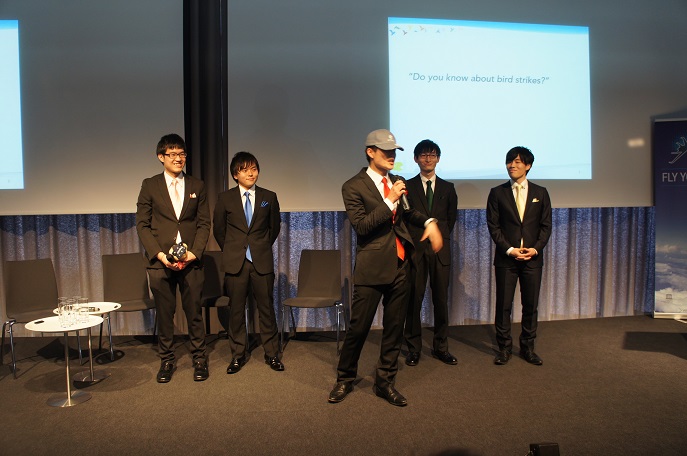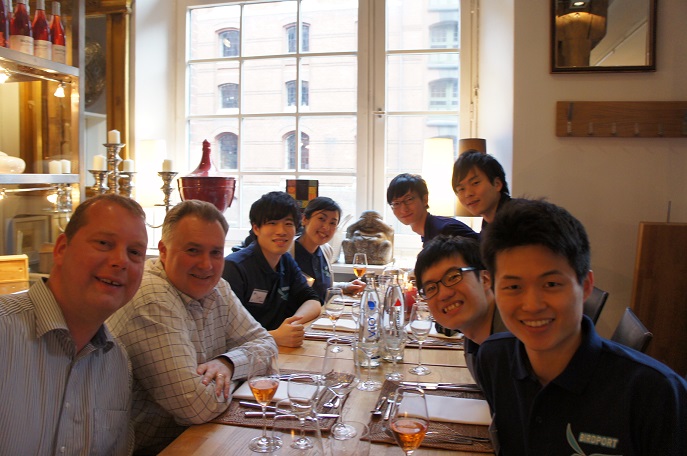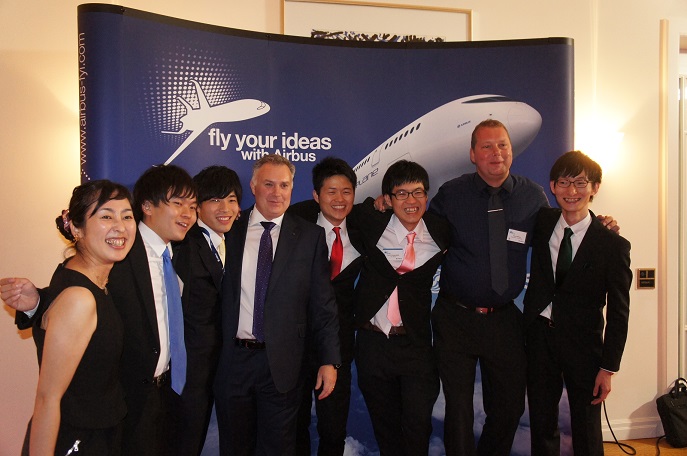"... and next we have Team Birdport from the University of Tokyo!"
On cue with the announcer’s words, five beaming young men strolled confidently towards the stage. Dressed in matching suits and each wearing a different-colored tie, they seemed to come straight out of a boy band, as one of the judges quipped, or perhaps from some sort of Power Rangers team. Since they were fourth out of five in the presenting order, Team Birdport knew they had to rouse up the sleepy audience. So, in true boy band-fashion, they began to sing.
"Birdport... Birdport... Birdport... BIRDPORT!"
Each of them sang the team’s name one after the other, and the harmony of this barbershop quintet certainly achieved the desired effect of grabbing the tired audience’s attention during this final presentation stage of the Fly Your Ideas contest.
Fly Your Ideas is a contest that seeks ideas from students around the world on improving and innovating aspects of the aviation industry. European aircraft maker Airbus has held the contest biennially since 2008, and over 15,000 students from 600+ universities in over 100 countries have submitted 1,676 ideas to be considered for the competition. The University of Tokyo’s team, Team Birdport, made it to the final round of the 2015 contest, so they and four other teams were flown out to Hamburg, Germany to give a presentation on their idea before a panel of expert judges, who would later announce the winning team. Winners receive a hefty sum of €30,000, while the runner-up team earns a very respectable €15,000, so the stakes are high in this competition.
The boys were naturals on stage. Sukrit, the self-proclaimed "bird lover," tenderly held on to his stuffed owl toy. Tomo’s large smile and resounding voice bounded through the Airbus venue. Tomoya’s calm, calculated coolness kept the team’s playful rambunctiousness in check. Similarly, the reassuring grin and steady demeanor of Motoki, the "drone freak" as his teammates affectionately called him, kept the team on track. Finally, the leader, Satoshi, was the absolute image of confidence as he projected the team’s passion for preventing bird strikes to the eager audience. Their plan, in a nutshell, is to use unmanned aerial vehicles, or drones, to guide flocks of birds from airports to comfortable habitats, or "birdports," which are a safe distance away from the airports. By doing so, they hope to prevent bird strikes, the phenomena that occur when planes hit birds, which can result in significant aircraft damage and flight delay. They also point out compassionate reasons for implementing their idea. "The sky is not only for humans, but also for birds," the students solemnly emphasize during their presentation.
On cue with the announcer’s words, five beaming young men strolled confidently towards the stage. Dressed in matching suits and each wearing a different-colored tie, they seemed to come straight out of a boy band, as one of the judges quipped, or perhaps from some sort of Power Rangers team. Since they were fourth out of five in the presenting order, Team Birdport knew they had to rouse up the sleepy audience. So, in true boy band-fashion, they began to sing.
"Birdport... Birdport... Birdport... BIRDPORT!"
Each of them sang the team’s name one after the other, and the harmony of this barbershop quintet certainly achieved the desired effect of grabbing the tired audience’s attention during this final presentation stage of the Fly Your Ideas contest.
Fly Your Ideas is a contest that seeks ideas from students around the world on improving and innovating aspects of the aviation industry. European aircraft maker Airbus has held the contest biennially since 2008, and over 15,000 students from 600+ universities in over 100 countries have submitted 1,676 ideas to be considered for the competition. The University of Tokyo’s team, Team Birdport, made it to the final round of the 2015 contest, so they and four other teams were flown out to Hamburg, Germany to give a presentation on their idea before a panel of expert judges, who would later announce the winning team. Winners receive a hefty sum of €30,000, while the runner-up team earns a very respectable €15,000, so the stakes are high in this competition.
The boys were naturals on stage. Sukrit, the self-proclaimed "bird lover," tenderly held on to his stuffed owl toy. Tomo’s large smile and resounding voice bounded through the Airbus venue. Tomoya’s calm, calculated coolness kept the team’s playful rambunctiousness in check. Similarly, the reassuring grin and steady demeanor of Motoki, the "drone freak" as his teammates affectionately called him, kept the team on track. Finally, the leader, Satoshi, was the absolute image of confidence as he projected the team’s passion for preventing bird strikes to the eager audience. Their plan, in a nutshell, is to use unmanned aerial vehicles, or drones, to guide flocks of birds from airports to comfortable habitats, or "birdports," which are a safe distance away from the airports. By doing so, they hope to prevent bird strikes, the phenomena that occur when planes hit birds, which can result in significant aircraft damage and flight delay. They also point out compassionate reasons for implementing their idea. "The sky is not only for humans, but also for birds," the students solemnly emphasize during their presentation.

The 20-minute presentation in English, followed by a five-minute question and answer session with the judges, was a big hit with all of the attendees. Judges, members of the media, Airbus executives, and even mentors for rival teams gave rave reviews of the students’ performance, which combined the serious subject of bird strikes with ample comedy and displayed the great teamwork among the five. According to Satoshi, their performance started out as just a dry research presentation, with team members and particularly the team’s academic mentor, Project Assistant Professor Hiroko Nakamura, gradually adding in interesting elements along the way. "I had to watch them practice this same speech so many times that I had to make it interesting for my sake," Nakamura joked.
"We practiced this presentation over 100 times!" Satoshi explains. And it shows. They didn’t even need to bring their script—which, by the way, was "version 12" according to the title—to the stage. They had it completely and utterly memorized, to the point that lines from the presentation were making appearances in their dreams. And with just a tiny bit of encouragement, they would all start saying their lines amongst each other at seemingly random times. These moments were met with uproarious laughter from all the team members, who were obviously enjoying the kinds of inside jokes that only teams this close could come up with.
The team members were not only close with each other and Professor Nakamura, but also with the two Airbus personnel assigned to assist with the team: mentor Danny Antons and expert Lee Dann. They had not met these two people in person prior to landing in Hamburg, but their friendship was readily apparent. They got along so well that the team presented them with heartwarming presents—custom-made Team Birdport t-shirts with their names and the names of the rest of the team inscribed on the back. This kind gesture deepened their bond which will surely last beyond the contest and for years to come.
After several months of preparation and making it through the first and second rounds, the students and Professor Nakamura arrived in Hamburg, Germany on Sunday, May 24th. They spent the next two days practicing their presentations with their mentors and fellow teams. On Tuesday evening, they were all bused to a classy restaurant where they met with members of the press, and were wined and dined until late in the evening, while the sun still shone brightly through the windows.
At the dinner, the students were excited and enthusiastic, showing no concerns about the final competition that would take place the next day. They jokingly recited their lines and chatted with the two Airbus employees assigned to their team. "We’ve been told by other teams that we’re very un-Japanese since we’re so loud and full of energy!" Satoshi said with a smile.
"We practiced this presentation over 100 times!" Satoshi explains. And it shows. They didn’t even need to bring their script—which, by the way, was "version 12" according to the title—to the stage. They had it completely and utterly memorized, to the point that lines from the presentation were making appearances in their dreams. And with just a tiny bit of encouragement, they would all start saying their lines amongst each other at seemingly random times. These moments were met with uproarious laughter from all the team members, who were obviously enjoying the kinds of inside jokes that only teams this close could come up with.
The team members were not only close with each other and Professor Nakamura, but also with the two Airbus personnel assigned to assist with the team: mentor Danny Antons and expert Lee Dann. They had not met these two people in person prior to landing in Hamburg, but their friendship was readily apparent. They got along so well that the team presented them with heartwarming presents—custom-made Team Birdport t-shirts with their names and the names of the rest of the team inscribed on the back. This kind gesture deepened their bond which will surely last beyond the contest and for years to come.
After several months of preparation and making it through the first and second rounds, the students and Professor Nakamura arrived in Hamburg, Germany on Sunday, May 24th. They spent the next two days practicing their presentations with their mentors and fellow teams. On Tuesday evening, they were all bused to a classy restaurant where they met with members of the press, and were wined and dined until late in the evening, while the sun still shone brightly through the windows.
At the dinner, the students were excited and enthusiastic, showing no concerns about the final competition that would take place the next day. They jokingly recited their lines and chatted with the two Airbus employees assigned to their team. "We’ve been told by other teams that we’re very un-Japanese since we’re so loud and full of energy!" Satoshi said with a smile.

Indeed, their energetic demeanors and constant horsing around didn’t fit the quiet and serious stereotype that many likely had of Japanese students. But behind their playful expressions lay a serious determination to compete, and this determination certainly showed during their presentation the next day.
The other four teams also had very intriguing ideas. Team Bolleboos, the all-female team from the UK with members from Spain, Italy and the Netherlands proposed a wireless power transfer system for taxiing airplanes that would allow them to be more environmentally friendly. Team Multifun, the all-Indian team from the Netherlands with members studying in India, the UK, the US and the Netherlands presented an idea for using piezoelectric fibers in a "skin" attached to the wings of airplanes to generate energy as the wings vibrate during flight. Team Aft Burner Reverser, the team from China, came up with an idea for an anti-collision system for aircraft to use when taxiing. Finally, Team Retrolley, the team of design students from Brazil, proposed a new design for garbage trollies used during flights that would make it easier to recycle trash resulting from in-flight meals and drinks.
After the judges were given a few hours to deliberate the results, everyone was ferried over to the venue for the Awards Ceremony and dinner party—a posh, Michelin 2-star restaurant within a hotel on the banks of the Elbe River. After all of the students were called to the stage to briefly share their thoughts on the contest, the runner up was announced: Team Retrolley, the team from Brazil. Then came the long-awaited announcement of the winner: Team Multifun, the team representing the Netherlands. Team Birdport and the other teams were understandably disappointed. "It’s like participating in the Olympics but not getting a medal," remarked Professor Nakamura. Still, they held their heads up high and kept smiling. They had, after all, gained valuable experiences and friendships over the course of the past year that will no doubt have a positive effect on them for the rest of their lives.
The other four teams also had very intriguing ideas. Team Bolleboos, the all-female team from the UK with members from Spain, Italy and the Netherlands proposed a wireless power transfer system for taxiing airplanes that would allow them to be more environmentally friendly. Team Multifun, the all-Indian team from the Netherlands with members studying in India, the UK, the US and the Netherlands presented an idea for using piezoelectric fibers in a "skin" attached to the wings of airplanes to generate energy as the wings vibrate during flight. Team Aft Burner Reverser, the team from China, came up with an idea for an anti-collision system for aircraft to use when taxiing. Finally, Team Retrolley, the team of design students from Brazil, proposed a new design for garbage trollies used during flights that would make it easier to recycle trash resulting from in-flight meals and drinks.
After the judges were given a few hours to deliberate the results, everyone was ferried over to the venue for the Awards Ceremony and dinner party—a posh, Michelin 2-star restaurant within a hotel on the banks of the Elbe River. After all of the students were called to the stage to briefly share their thoughts on the contest, the runner up was announced: Team Retrolley, the team from Brazil. Then came the long-awaited announcement of the winner: Team Multifun, the team representing the Netherlands. Team Birdport and the other teams were understandably disappointed. "It’s like participating in the Olympics but not getting a medal," remarked Professor Nakamura. Still, they held their heads up high and kept smiling. They had, after all, gained valuable experiences and friendships over the course of the past year that will no doubt have a positive effect on them for the rest of their lives.






